CARE LABEL SYMBOLS
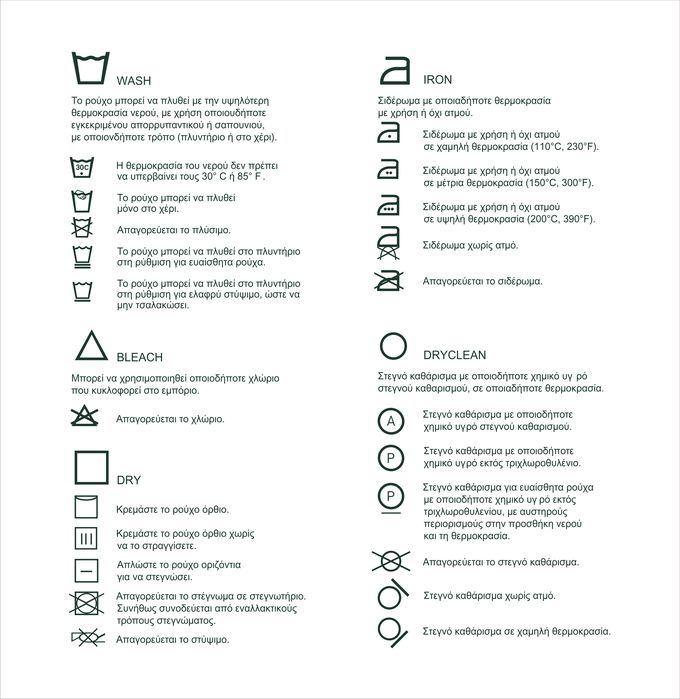
IRONING TIPS
• You should check the labels of the clothes to see the proper temperature that must be ironed.
• Usually linens ironed at temperatures over 60 °C, cottons over 40 °C and wool, silk and synthetic fabrics at lower temperatures.
• The clothes bearing a print should be ironed in reverse side of the point of printing, and at low temperatures.
• Buttons, buttonholes, labels, fasteners and in general the accessories of the garment should not come in contact with the iron, because they are destroyed.
We start the ironing of a shirt from the Collar. First we iron the back side of the collar with direction from edges to center, and then the normal side.
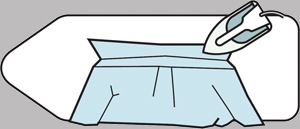
We continue with the Sleeves, starting from the cuffs. If it is a double cuff we iron both sides. 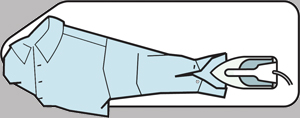
Then we iron the Shoulders and the Back parts of the shirt.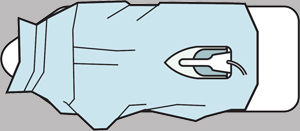
Finally we iron the Front parts, first the reverse and then the normal side.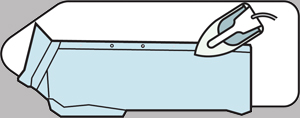
Afterwards, we fold the shirt, or even better, hang it on a hanger.
LAUNDRY TIPS
• Before washing we separate the white from the colorful clothes and we wash them at the right temperature between 30-50 °C, according to label indications.
• High temperatures are not advisable for any fabric.
• Chloride should be avoided. Use color safe bleach on dyed cottons.
• Whiteners are preferred instead of chloride detergents that destroy the fibers of clothes.
• Use neutral detergents for frail clothes.
• Dissolve well the detergent, so as to avoid stains. For machine washing in low temperatures, liquid detergents are preferable.
• Do not add the fabric softener before the rinse cycle, because it loses its effectiveness.
• Avoid using more than the indicated amount of detergent as it may leave residue on your clothes, and additionally is not environmental friendly.
• The wring of the washing machine is allowed in low spins.
• The clothes should be hanged out immediately after washing.
• Washing and hanging out of clothes, should always be done on reverse.
• It is good to avoid the laundry machine's dryers.
• The sun drying wears out the clothes, so it is preferable to dry your clothes in an internal space.
• Garments that have been manufactured by fabrics already been washed or fade out progressively, so that they provide an image of used – such as jeans and delave, it is essential to be washed separately and avoid local stain removal.
• The dark colors slack from repeated washings
• The non pre-washed clothes after repeated washes can present a fluctuation of 2% in their size, (mainly in the collar and the sleevelets).
SHIRTS
• It is recommended that shirts be washed immediately after purchase and before worn, in order the ironing glue be removed.
• The sooner you wash a shirt after use, the better, so as not to allow time for the stain to act on the fiber of clothing.
STAINS REMOVAL
Beer
Sponge the stain with warm water in which you have poured a little quantity ofwhite vinegar. Check first if the garment bleaches by making a test on an internal partof it. Rinse thoroughly with water. Wash the garment normally by hand or machine wash with a detergent of your choice.
Blood
Treat the stain immediately and quickly. If the stain is still fresh remove it by throwing lots of cold running water at the back of its side.If the stain remains, or is old, soak thegarment in a basin with cold salted water, (2 table spoons salt per liter of water) for 2-3hours. During this time you should refresh the salted water constantly until it remains clear.Then wash the garment in the washing machine with regular detergent of your choice.
Chocolate
Put the garment in a plastic bag and place it in the freezer for a few minutes in orderto harden the chocolate. Then, carefully scrape most of the chocolate with the side of the knife that doesn’t cut. Wipe the stain with a sponge dipped in warm detergent solution. Wash the garment with detergent of your choice at the maximum temperature written onthe label of the garment.
If the stain persists, soak the garment over night in 5 liters of water in which you have dissolved 1 scoop of detergent of your choice, while allowing thetemperature written on the garment’s label. Always check if the garment bleaches by making a test in an internal part of it. Wash the garment with detergent of your choice atthe maximum allowed temperature written on the label of the garment.
Coffee – Tea – Beetroot – Grass
Soak the garment over night in 5 liters of water in which you have dissolved 1 scoopof detergent of your choice. The water temperature should be the allowed one displayed in the label of the garment. Always check if the garment bleaches by making a test in an internal part of it. Wash the garment as usual.
Egg
Pour plenty of cold running water at the back of the stain and wash the cloth immediatelywith detergent of your choice. If the stain is large and remains after the rinsing with water,let the garment soak for half an hour in water to which you have dissolved 1 scoopof detergent, at the allowed temperature written on the garment’s label. Checkfirst if the garment bleaches by making a test on an internal part of it.Then wash the garment as usual.
Foam -Shaving Cream - Toothpaste - Sunscreen Lotion
Check first if the garment bleaches by making a test in an inner part of it. Make a cleaning solution by dissolving one tea spoon of dish washing liquid to one cup of warm water in which you have added 3-4 drops of white vinegar. Sponge the stain with waterlocally. Dampen a cloth towel with the cleaning solution, wring it out slightly and place it over the stain. Press the cloth a few times over the stain. Rinse with water. Damp anotherclean absorbent cloth with alcohol, wring it out slightly and press onto the stain to remove it. Repeat the process until is completely gone by using another cloth each time.
If left-residue, pour a few drops of peroxide (hydrogen peroxide 3%). Leave for 1-2 minutesand rinse with water. To remove any residual peroxide on the stain, apply white vinegar in water at proportion of 1 part vinegar to 2 parts water. Rinse again with water. Wash the garment as usual.
Fruit Juice
Rinse the stain from the reverse side with cold water. Soak the garment over night in 5 liters of water in which you have dissolved 1 scoop of detergent of your choice. The water temperature should be the allowed one displayed in the label of the garment. Always check if the garment bleaches by making a test in an internal part of it. Wash the garment as usual.
Chewing Gum
Put the garment in a plastic bag and place it in the freezer in order to harden the gum.Then, break the surface of the gum into small pieces and remove them carefullywith a tweezers. Beware of avoiding the pulling of threads on knitwear. Remove any leftovers by pressing a pad in which you have pour a little gasoline or oil of eucalyptus.
Always check if the garment bleaches by making a test in an internal part of it. Wash the garment with detergent of your choice at the maximum temperature written on the garment’s label.
Ink
Ink stains are difficult to be completely removed. Follow these instructions:
If the ink is not soluble in water
On a dry cloth, or absorbent 2-3 sheets of paper towel, place the garment with the stain facing down. Put a little alcohol on the stain and by using a dry absorbent white cloth remove the ink. Always check if the garment bleaches by making a test on an internal part of it. Repeat the process until no ink comes out.
Soak the garment overnightin 5 liters of water in which you have dissolved 1 scoop of detergent of your choice, whileallowing the temperature written on the garment’s label. Always check if the garment bleaches by making a test on an internal part. After soaking, wash the garment as usual.
If the ink is soluble in water:
Soak the garment overnight in 5 liters of water in which you have dissolved 1 scoop ofdetergent of your choice, while allowing the temperature written on the garment’s label. Prior to soaking, gently rub the stain area with a warm detergent solution. Always check if the garment bleaches by making a test in an internal part of it. After soaking, wash the cloth with a detergent of your choice at the maximum temperature that allows the fabric.
Lipstick-Mascara Eyeshadow - Make Up
Rub gently the stain with a liquid detergent of your choice. Wash the cloth immediately at the maximum temperature allowed by the label of the garment. -If the stain persists place the stained area in a liquid ammonia solution1% for 3-5 minutes, and wash immediatelyafter with a liquid detergent of your choice.
Mold and Fungi
The stains of mold fungus are usually difficult to remove.Soak the garment over night in 5 liters of water in which you have dissolve 1 scoop of detergent of your choice. The water temperature should be the allowed, written on the garment’s label. Always check if the garment bleaches by making a test on an internal part of it. After soaking, wash the garment as usual. If the stain remains, repeat the process.
If the laundry care label allows it, use bleach based on chlorines follows: Soak the cloth for 20-30 minutes at 5 liters of water containing 1 cup chlorine while allowing the temperature that is written on the garment’s label. Rinse and then wash the garment as mentioned above.
Νail Polish
Turn the fabric at the back side. Pour some nail bleach behind the stain. Always check if the garment bleaches by making a test in an internal part of it. Press the stain onto a clean cloth or 2-3 paper towels to absorb the polish. Immediately wash with detergent of your choice at the maximum temperature written on the label of the garment.
CAUTION: Do not apply the above procedure to synthetic clothes from acetate, or ray on triasetat. It is best to consult a professional dry cleaner.
Oil – Grease
If the stain of fat is fresh, sprinkle the stain with talc powder and rub gently onto thefabric with your fingers. Let it stay for 20-30 minutes and then brush. Wash the cloth with a detergent of your choice at the maximum temperature that allows the fabric.
Oil paint
Treat the stain immediately before it dries. Turn the fabric on the back side. Pour somepaint diluents from the one you used for the paint (e.g. white spirit) behind the stain.Always check if the garment bleaches by making a test on an internal part of it.
Press the stain onto a clean cloth, or 2-3 layers of paper towel to absorb the paint. Wash the cloth with a detergent of your choice at the maximum temperature that is written on the fabric’s label.
Paint
Treat the stain immediately before it dries. Turn the fabric on the back side. Place the garment under a tap with running water from the reverse side to wash off the paint. Wash the cloth with a detergent of your choice at the maximum temperature that allows the fabric.
Rust
Rub lemon juice on the rust. Leave for an hour in the sun. Wash the cloth with a detergent of your choice at the maximum temperature written on the label.
Tomato Sauce
Remove most of the sauce with the help of a knife from the side that does not cut. Place the garment under a tap with running water from the reverse side to wash out thesauce.
If the stain persists, soak the garment over night in 5 liters of water in which you have dissolved ½ oz detergent of your choice. The water temperature should be the allowed one written on the garment’s label. Always check if the garment bleaches by making a test on an internal part of it.
Wax
Allow the wax to dry. Carefully scrape most of the wax with the help of a knife from the side that does not cut. Place the stained portion of the fabric between two ink absorbentpaper, sor 2-3 paper towel sand, iron the stain over medium heat without steam to melt thewax and left to be absorbed by the paper.
Change the papers several times so as to avoid the wax to return to the fabric. Allow the garment to cool. Sponge-lightly the surface of thestain with a little petrol or white alcohol and remove the fluid by pressing on some kitchen paper to remove any stain left over’s. Check first if the garment bleaches by testing on an internal part of it.

